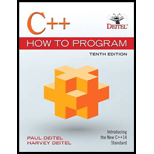
C++ How to Program (10th Edition)
10th Edition
ISBN: 9780134448237
Author: Paul J. Deitel, Harvey Deitel
Publisher: PEARSON
expand_more
expand_more
format_list_bulleted
Concept explainers
Textbook Question
Chapter 2, Problem 2.26E
(Checkerboard Pattern) Display the following checkerboard pattern with eight output statements, then display the same pattern using as few statements as possible.

Expert Solution & Answer
Want to see the full answer?
Check out a sample textbook solution
Students have asked these similar questions
4. |z + 5 - 5i| = 7
14.
dz,
C: |z❘
C: |z❘ = 0.6
ze² - 2iz
H
14.
dz,
C: |z❘
C: |z❘ = 0.6
ze² - 2iz
H
Chapter 2 Solutions
C++ How to Program (10th Edition)
Ch. 2 - Discuss the meaning of each of the following...Ch. 2 - Fill in blanks in each of the following: a)...Ch. 2 - Write a single C++ statement or line that...Ch. 2 - State which of the following are true and which...Ch. 2 - Fill in the blanks in each of the following: a)...Ch. 2 - What, if anything, prints when each of the...Ch. 2 - Which of the following statements contain...Ch. 2 - Given the algebraic equation y — ax 3 + 7. which...Ch. 2 - (OrderofEvaluation) State the order of evaluation...Ch. 2 - (Arithmetic) Write a program that asks the user to...
Ch. 2 - (Printing) Write a program that prints the numbers...Ch. 2 - (Comparing Integers) Write a program that asks the...Ch. 2 - (Arithmetic, Smallest and Largest) Write a program...Ch. 2 - (Diameter, Circumference and Area of a Circle)...Ch. 2 - (Displaying Shapes with Asterisks) Write a program...Ch. 2 - What does the fallowing code print? Cout “*\n...Ch. 2 - (Largest and Smallest Integers) Write a program...Ch. 2 - (Odd or Even) Write a program that reads an...Ch. 2 - (Multiples)Write a program that reads in two...Ch. 2 - (Checkerboard Pattern) Display the following...Ch. 2 - (Integer Equivalent of a Character) Here is a peek...Ch. 2 - (Digits of an Integer) Write a program that inputs...Ch. 2 - (Table) Using the techniques of this chapter,...Ch. 2 - (Body Mass Index Calculator) We introduced the...Ch. 2 - (Car-Pool Savings Calculator) Research several...
Additional Engineering Textbook Solutions
Find more solutions based on key concepts
Which of the following are illegal variable names in Python, and why? x 99bottles july2009 theSalesFigureForFis...
Starting Out with Python (4th Edition)
The solid steel shaft AC has a diameter of 25 mm and is supported by smooth bearings at D and E. It is coupled ...
Mechanics of Materials (10th Edition)
Write a summary list of the problem-solving steps identified in the chapter, using your own words.
BASIC BIOMECHANICS
Why is the study of database technology important?
Database Concepts (8th Edition)
Assume a telephone signal travels through a cable at two-thirds the speed of light. How long does it take the s...
Electric Circuits. (11th Edition)
How are relationships between tables expressed in a relational database?
Modern Database Management
Knowledge Booster
Learn more about
Need a deep-dive on the concept behind this application? Look no further. Learn more about this topic, computer-science and related others by exploring similar questions and additional content below.Similar questions
arrow_back_ios
SEE MORE QUESTIONS
arrow_forward_ios
Recommended textbooks for you
 C++ Programming: From Problem Analysis to Program...Computer ScienceISBN:9781337102087Author:D. S. MalikPublisher:Cengage Learning
C++ Programming: From Problem Analysis to Program...Computer ScienceISBN:9781337102087Author:D. S. MalikPublisher:Cengage Learning C++ for Engineers and ScientistsComputer ScienceISBN:9781133187844Author:Bronson, Gary J.Publisher:Course Technology Ptr
C++ for Engineers and ScientistsComputer ScienceISBN:9781133187844Author:Bronson, Gary J.Publisher:Course Technology Ptr Microsoft Visual C#Computer ScienceISBN:9781337102100Author:Joyce, Farrell.Publisher:Cengage Learning,
Microsoft Visual C#Computer ScienceISBN:9781337102100Author:Joyce, Farrell.Publisher:Cengage Learning,

C++ Programming: From Problem Analysis to Program...
Computer Science
ISBN:9781337102087
Author:D. S. Malik
Publisher:Cengage Learning

C++ for Engineers and Scientists
Computer Science
ISBN:9781133187844
Author:Bronson, Gary J.
Publisher:Course Technology Ptr

Microsoft Visual C#
Computer Science
ISBN:9781337102100
Author:Joyce, Farrell.
Publisher:Cengage Learning,
Literals in Java Programming; Author: Sudhakar Atchala;https://www.youtube.com/watch?v=PuEU4S4B7JQ;License: Standard YouTube License, CC-BY
Type of literals in Python | Python Tutorial -6; Author: Lovejot Bhardwaj;https://www.youtube.com/watch?v=bwer3E9hj8Q;License: Standard Youtube License